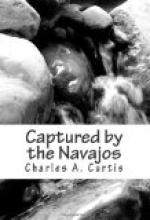“There is a small herd of deer there, sure enough,” I replied, after making out the objects through my glass. “We shall not want for venison if we have good luck with our rifles.”
“Deer, antelope, turkeys, ducks, geese, sand-hill crane, and trout!” exclaimed Frank. “We’ve hit a hunter’s paradise.”
“And bears and catamounts, too, I suspect,” said Henry, looking a little lugubrious.
“My, but wouldn’t I like to kill a bear!” said Frank.
“Well, I don’t believe I shall hunt for one, and I hope a bear won’t hunt for me,” said the younger lad. “I’ll be satisfied with turkeys, grouse, ducks, and trout.”
Six miles due west, a little south of the wooded point, detached from it about half a mile, we perceived a line of small cabins, which we inferred was the volunteer encampment. They stretched across a little level space, enclosed by a gently sloping ridge of horseshoe shape. The ridge, in fact, proved to be of that shape when we examined it later. The row of sixteen cabins stretched across the curve, and looked out of the opening towards the eastern side of the valley. Fifty yards in front of the cabins, running across the horseshoe from heel to heel, flowed a crystal stream of water twenty feet wide and two feet deep, which rose from forty-two springs near the northern end of the valley. The ridge enclosing the encampment was nowhere more than twenty-five feet above the level parade.
The cabins were built of pine logs laid up horizontally, flanked on the north by the kitchen and stable, and on the south by a storehouse. Behind the cabins, at the centre of the horseshoe curve, two-thirds the way up the slope of the ridge, and overlooking the encampment from its rear, stood the guard-house, in front of which paced a sentinel.
Resuming our march, a brisk step soon brought us to the encampment. At the brook before the parade I was met by the volunteer officers, who did not disguise their joy at the prospect of leaving what they considered a life of unbearable exile. Even before the customary civilities were passed, the captain asked me if my animals were in a condition to warrant his loading the wagons with his company property as soon as I unloaded mine, as he wished to make an evening’s march towards Santa Fe.
I told him I thought they were, provided he took the two wagons belonging to the camp in addition, so that the loads would be light. He approved of my suggestion, and promised to send back the wagons as soon as he reached Fort Marcy.
The wood-yard being well supplied with fuel, I saw no reason why the wagons and mules could not be spared the ten days necessary to make the round trip.
One reason for doing all I could to facilitate the immediate departure of the Californians was that my men were anxious to move into the cabins at once.




